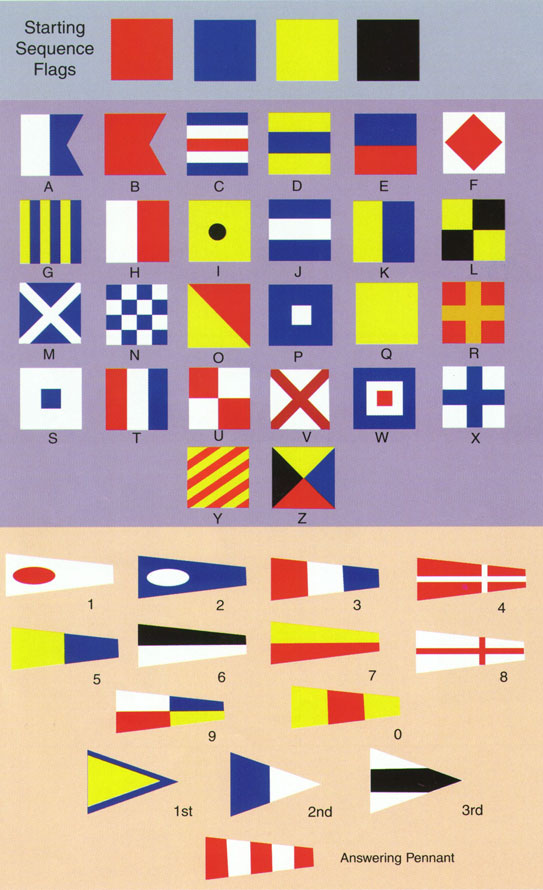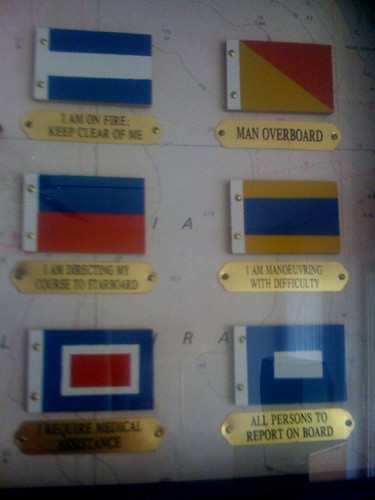Guide to Nautical Alphabet
Nautical flags are an international code system used for two ships to signal to each other or for a ship to signal to shore. They are also called signaling nautical flags. Using a group of different colored flags, shaped flags, and markings each one has a different meaning. The flags can be used alone or in combination with another flag.
Nautical flags are made up of 26 square flags (which represent the letters of the alphabet) along with 10 numbered pendants; one answering pendant and three substitutes or repeaters. At sea, only a few flag colors are easily recognized, these are: red, blue, yellow, black, and white and they cannot be mixed indiscriminately. For easy recognition nautical flags are either red and white, yellow and blue, blue and white, black and white along with plain red, white, and blue.

Nautical flags and the knowledge of their meanings are valuable at sea in case of danger or breakdowns in other communications systems such as radio. One-flag signals are urgent or common signals.
- Two-flag signals are used mostly for distress and maneuvering.
- Three-flag signals are for points of the compass, relative bearings, standard times, verbs, punctuation, and also general code and decode signals.
- Four flags are used for geographical signals, names of ships, bearings, etc.
- Five-flag signals are used to relate time and position.
- Six flag signals are used to indicate north or south east or west in latitude and longitude signals.
- Seven flags are for longitude signals containing more than one hundred degrees.
There are also flags used in nautical racing that signal to the competitors what they are supposed to do.
International meanings for nautical flags:
- A: Alpha – diver down; keep clear
- B: Bravo – carrying dangerous cargo
- C: Charlie – yes
- D: Delta – keep clear
- E: Echo – altering course to starboard
- F: Foxtrot – I am disabled
- G: Golf – I want a pilot
- H: Hotel – a pilot on board
- I: India – I am altering course to port
- J: Juliet – vessel on fire keep clear
- K: Kilo – I want to communicate with you
- L: Lima – stop your vessel instantly
- M: Mike -my vessel is stopped
- N: November – no
- O: Oscar – Man overboard
- P: Papa – vessel is about to sail
- Q: Quebec – I request free pratique
- R: Romeo – reverse course
- S: Sierra – engines are going astern
- T: Tango – keep clear
- U: Uniform – you are heading into danger
- V: Victor – require assistance
- W: Whiskey – require medical assistance
- X: X-ray – stop your intention
- Y: Yankee – am dragging anchor
- Z: Zulu – I require a tug
Understanding the Nautical Alphabet
The phonetic alphabet consists of a set of words that represent each letter of the alphabet. For example, “alpha” represents the letter A, “bravo” represents the letter B, and so on. Each word is carefully chosen to be distinct and easily distinguishable, even in noisy or challenging environments.
This alphabet plays a key role in maritime communication, particularly in radio transmissions, where messages can be affected by static, interference, or poor audio quality. By using the phonetic alphabet, sailors can ensure that their messages are received accurately and clearly, even in less-than-ideal conditions.

The use of the phonetic alphabet contributes to a common language among sailors worldwide. It allows for seamless communication between ships, air traffic control, and maritime authorities, ensuring efficient coordination and response during emergencies or navigational challenges.
Learning the phonetic alphabet is not only crucial for sailors but also a fascinating aspect of maritime culture. It adds an additional layer of intrigue and professionalism to the nautical world. Mastering this alphabet enables sailors to confidently communicate their location, vessel details, and other important information without confusion or misinterpretation.
Common Nautical Abbreviations and Acronyms
Understanding these shorthand symbols is crucial for smooth and efficient maritime operations. So, let’s dive deep into the common abbreviations and acronyms used in nautical communications.
First up, we have the International Code of Signals (ICS), which is a standardized system used worldwide for maritime communication. It consists of flags, pennants, and sound signals, each representing a specific letter or message. For example, the letter “A” is represented by the Alpha flag, “B” by the Bravo flag, and so on.

In addition to the ICS, there are various abbreviations and acronyms specific to nautical communications. For instance, “ETA” stands for Estimated Time of Arrival, indicating the expected time a vessel will reach its destination. “SOLAS” refers to the International Convention for the Safety of Life at Sea, which sets minimum safety standards for ships.
Other commonly used abbreviations include:
- “LOA” (Length Overall)
- “SOG” (Speed Over Ground)
- “COG” (Course Over Ground)
- “DSC” (Digital Selective Calling), is a method of transmitting distress signals via digital radio.
Furthermore, the maritime industry uses abbreviations to identify different types of vessels.
- “VLCC” refers to Very Large Crude Carriers
- “LPG” represents Liquefied Petroleum Gas carriers
These abbreviations help categorize vessels and facilitate efficient communication among maritime professionals.
Understanding these abbreviations and acronyms is essential for anyone involved in the maritime industry, whether you’re a sailor, a maritime student, or simply a curious enthusiast. It allows for clear and concise communication, ensuring safety, efficiency, and effective coordination on the high seas.
So, the next time you hear a sailor say “ETA at 0800,” or see flags flying high on a vessel, you’ll be equipped with the knowledge to decode the nautical alphabet and understand the language of the sea.
